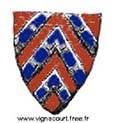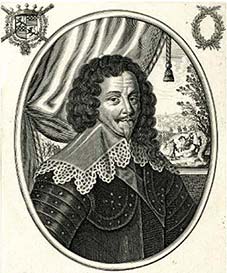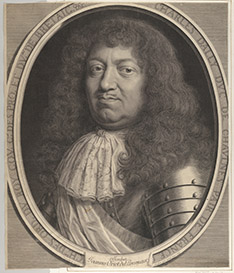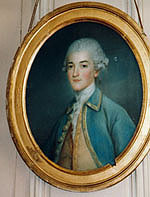Lordship of Vignacourt
Several lords bore the title Vidame d'Amiens, which was uncommon among the French nobility. Vidame is a word of Latin origin, from Vicedominus, linked to the feudal status of the territory. They took care of the upkeep of their domain, as well as local monuments and communication routes.
The Sieur de Varennes left his name on the Varennes wood adjoining the Vignacourt forest. Hornas Street comes from the fiefdom of Sieur Brunel d'Horna.
The documentary sources are sometimes opposite in the chronology of events and should be subject to more in-depth research. The seigneury of Vignacourt belonged to the families described below.
![]()
- AMIENS family
- Family Varennes,
- Family Rayneval,
- Family d' AILLY,
- of Albert Duke of Chaulnes,
- of Liefman CALMER,
- of Charles François DESELLE.
Family D'AMIENS
Adam D'AMIENS
The oldest known of the lineage, he was Lord of Amiens, residing at the citadel, the Amiens fortress called Castillon at that time. He lived around the 1100s.
His wife was Béatrice de Boves. They had two sons, Hugues and Guy 1er of Amiens. Hugues became Archbishop of Rouen. He took theology courses in Laon, but he was a native of Amiens. He was buried in 1164 in Rouen Cathedral, where it is possible to see the recumbent figure.

Coat of arms of family d'Amiens, Lord of Vignacourt.
Guy I of AMIENS
Lord and prince of Amiens, Lord of Flixecourt, Vinacourt, and La Broye, inter alia
He was married to Mathilde d'Enguerrand de Boves in 1112, and they had a son, Aleaume. He was related to the King of England, Henry I.
King Louis VI destroyed the castle of Amiens, despite the energy deployed by Guy I of Amiens to avoid it. The king seized the castle after several attempts and ordered its demolition in 1117.
Aleaume d'Amiens
His first name was sometimes written in this way: "Alerme". He was lord of Flixecourt, Etoile, and Outrebois. He was the father of Guy D'Amiens.
He was buried in the priory of Moreaucourt, of which he was the founder, in 1146. This site, located in the village of l'Etoile, had been rebuilt several times despite almost disappearing during the revolution; however, some remains are still visible. Aleaume died on June 21, 1175.
Guy II D'AMIENS
He was the Lord of Amiens, Vignacourt, Flixecourt, Canaple, Etoile, and Flesselles, including Talmas. He was married to Miss Thomas of Boves, and two children were born:
- Pierre d'Amiens (died in 1208).
- Dreux d'Amiens, the elder.
Dreux d'AMIENS
Knight Lord of Vignacourt, Flixecourt, and d'Aubigny, inter alia. His wife's name was Marguerite Comte de Saint-Pol, and they had five children, including Regnault d'Amiens.
Regnault D'AMIENS
Lord of Vignacourt and Flixecourt, among others. He was deeply Christian, which is why he founded the collegiate church of Vignacourt.
He was initially a canon at the Amiens cathedral in 1200. The ancient cathedral of Amiens burned in 1218 after being struck by lightning.
At the death of his brother, he resigned from this function and was married to Mathilde. They had several children, including Dreux II d'Amiens. Regnault was buried in Vignacourt collegiate next to his wife in 1227.
The coat of arms of the d'Amiens family is composed of three rafters. The village of Flixecourt uses these symbols, which is 6 miles from our town.
Dreux II D'AMIENS
Lord of Vignacourt and Flixecourt, inter alia. He was the father of two daughters:
- Marguerite was married to Enguerrand of Fiefs in 1276,
- Jeanne, Dame de La Broye.
Family VARENNES
Jean de VARENNES
Lord of Vignacourt, Flixecourt.
His wife's name was Agnès d'Aubigny, Lady of La Broye, who passed away prematurely in 1227. They had a son named Jean.
Jean II de VARENNES
Lord of Vignacourt, of Flixecourt, including La Broye. He was married in 1281 to Jeanne of Picquigny.
Jean III de VARENNES
Lord of Vignacourt, Flixecourt, and La Broye. His wife was called Isabelle de Wallencourt. A daughter named Jeanne was born of this union.
Jeanne de VARENNES
Jeanne’s husband’s name was Wallerand de Rayneval. They had three children, including:
- Jean de Rayneval. He lost his life at the Battle of Agincourt.
- Aubert de Rayneval also died on October 25, 1415.
- Jeanne de Rayneval, only daughter.
Jeanne de Rayneval
Jeanne was married to Baudouin d'Ailly in 1387, vidame of Amiens, Baron de Picquigny, lord of Vignacourt. The origin of the Ailly family is in Ailly-le-Haut-Clocher village.
Baudouin served King Charles V as a knight. He passed away at the Battle of Agincourt. Jeanne gave birth to two children:
- Raoul III of Ailly,
- Jeanne d'Ailly.
Raoul III d'Ailly
Raoul was lord of Varennes, Rayneval, and Vidame d'Amiens.
He was married to Jacqueline de Bethune in 1413. Several children were born from this union, including Jean d'Ailly.
Jean d'Ailly
Jean was born in Raineval. He had the titles of Vidame d'Amiens and Lord of Rayneval.
His wife's name was Yolande of Bourgogne. They had three children, including Charles d'Ailly.
Charles d'Ailly
He had the title of Amiens vidame, linked to the feudal status of the territory.
A son named Antoine was born of his union with Philippa de Crèvecoeur.
Antoine d'Ailly
He married Marguerite de Melun on October 29, 1518. She gave birth to a boy named Philibert-Emmanuel d'Ailly.
Philibert-Emmanuel d'AILLY
Lord of Vignacourt, of Flixecourt, vidame of Amiens, Baron de Picquigny, knight of the order of the King. His wife was Louise d'Ognies.
They had four children, including three deceased young sons and Charlotte-Eugénie d'Ailly. She married Honoré du Duc de Chaulnes.
Honoré d'ALBERT, Duke of Chaulnes
Knight of the King's Orders, Marshal of France, General in Picardy, Governor of the City, and the Citadel of Amiens.
His union with Charlotte-Eugénie d'Ailly was accepted on the condition that his descendants perpetuate the name of d'Ailly, and they had two sons:
- Henri-Louis d'Ailly was married to Miss de Neufville de Villeroy. A girl was born from this union.
- Charles of Albert, Ailly, Duke of Chaulnes.

Honoré of Albert, Duke of Chaulnes © The British Museum
Charles d'ALBERT, D'AILLY, Duke of Chaulnes
Charles was born in 1625. Upon the death of his elder brother, he inherited the title of Duke of Chaulnes. His wife was named Elisabeth le Féron. They had no children.
He was lieutenant-general of the king’s armies, governor of Amiens, governor of Brittany, and French ambassador to Rome from 1666 to 1668, in 1670, and from 1689 to 1691. He bequeathed his legacy to his nephew, Louis Auguste d'Albert d'Ailly, in 1698.

Charles d'Albert d'Ailly © Met Museum
Louis Auguste d'Albert d'AILLY, Duc de Chaulnes
Louis was born in 1676. He became Lieutenant General of Picardy in 1692.
He had the titles of Vidame d'Amiens, Count of Picquigny, Duke of Chaulnes, brigadier of the King's armies, and Captain Lieutenant of the Company of the 200 light horses of the ordinary guard of his majesty.
His wife was Marie Anne Romaine de Beaumanoir, whose father was the governor of Brittany. He lost his life in Finistère, Morlaix, in 1744.
Michel Ferdinand d'Albert d'AILLY, Duc de Chaulnes
Michel was married to Anne-Joseph Bonnier de la Mosson in 1734.
He was a physicist, astronomer, and governor of Amiens, later Corbie, in 1743. Furthermore, he was President of the Royal Academy of Sciences in 1746, 1750, and 1759. He commissioned several physical instruments, such as a bronze microscope, between 1750 and 1760, which can be seen at the Musée des Arts et Métiers in Paris. He died in 1769.
Louis Joseph d'ALBERT, d'AILLY, Duc de Chaulnes
Louis Joseph was born in 1741. He was married to Marie Paul Angélique of Albert de Luynes in 1758 in the Paris region.
He sold the lordship of Vignacourt on April 27, 1774, to Pierre Bryet.
Pierre BRYET
He was a squire, and called Sieur of Bernapré. A year later, on April 25, 1775, he resold the lordship to Liefman CALMER.
Liefman CALMER
Liefman was born in northern Germany at Aurich in 1711 (Niedersachsen). He moved to La Haye in Holland, where he thrived; afterward, he moved to Paris in 1769.
He acquired the titles of Lord of Vignacourt, Vidame of Amiens, and Baron of Picquigny with the purchasing credits of the Duke of Chaulnes in 1774. He passed away in Paris 10 years later, in 1784. His wife, Rachel Moïses Isaakes, was buried in the Paris Pere-Lachaise cemetery in 1817.
Charles François DESELLE
Lord of Chatellenie of Vignacourt, Breilly-sur-Somme (8 mi from Vignacourt), Toulay (near Breilly), and, among others, Knight, King’s Councillor, and Vidame of the City of Amiens.
Lord of the counties of Mesnil-Saint-Denis and Beaurain. He lived in Paris on "Francs Bourgeois" street in 1774. He died in 1814 at around 65 years old.
His name was written differently according to the sources, but for Vignacourt, the spelling was DESELLE at the date of the French Revolution.

Charles-François DESELLE portrait © Olivier Faveau
A portrait painted by Joseph Ducreux XVIII, the Marie-Antoinette painter,
info on the link below: mesnil.saint.denis.free.fr
